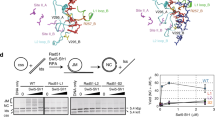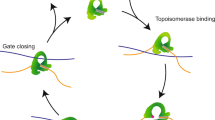Abstract
Many helicases modulate recombination, an essential process that needs to be tightly controlled. Mutations in some human disease helicases cause increased recombination, genome instability and cancer. To elucidate the potential mode of action of these enzymes, here we developed a single-molecule fluorescence assay that can visualize DNA binding and translocation of Escherichia coli Rep, a superfamily 1 DNA helicase homologous to Saccharomyces cerevisiae Srs2. Individual Rep monomers were observed to move on single-stranded (ss)DNA in the 3′ to 5′ direction using ATP hydrolysis. Strikingly, on hitting a blockade, such as duplex DNA or streptavidin, the protein abruptly snapped back close to its initial position, followed by further cycles of translocation and snapback. This repetitive shuttling is likely to be caused by a blockade-induced protein conformational change that enhances DNA affinity for the protein's secondary DNA binding site, thereby resulting in a transient DNA loop. Repetitive shuttling was also observed on ssDNA bounded by a stalled replication fork and an Okazaki fragment analogue, and the presence of Rep delayed formation of a filament of recombination protein RecA on ssDNA. Thus, the binding of a single Rep monomer to a stalled replication fork can lead to repetitive shuttling along the single-stranded region, possibly keeping the DNA clear of toxic recombination intermediates.
This is a preview of subscription content, access via your institution
Access options
Subscribe to this journal
Receive 51 print issues and online access
$199.00 per year
only $3.90 per issue
Buy this article
- Purchase on Springer Link
- Instant access to full article PDF
Prices may be subject to local taxes which are calculated during checkout



Similar content being viewed by others
References
Lohman, T. M. & Bjornson, K. P. Mechanisms of helicase-catalyzed DNA unwinding. Annu. Rev. Biochem. 65, 169–214 (1996)
Byrd, A. K. & Raney, K. D. Protein displacement by an assembly of helicase molecules aligned along single-stranded DNA. Nature Struct. Mol. Biol. 11, 531–538 (2004)
Fairman, M. E. et al. Protein displacement by DExH/D “RNA helicases” without duplex unwinding. Science 304, 730–734 (2004)
Kaplan, D. L. & O'Donnell, M. DnaB drives DNA branch migration and dislodges proteins while encircling two DNA strands. Mol. Cell 10, 647–657 (2002)
Lee, M. S. & Marians, K. J. Differential ATP requirements distinguish the DNA translocation and DNA unwinding activities of the Escherichia coli PRI A protein. J. Biol. Chem. 265, 17078–17083 (1990)
Kawaoka, J., Jankowsky, E. & Pyle, A. M. Backbone tracking by the SF2 helicase NPH-II. Nature Struct. Mol. Biol. 11, 526–530 (2004)
von Hippel, P. H. Helicases become mechanistically simpler and functionally more complex. Nature Struct. Mol. Biol. 11, 494–496 (2004)
Krejci, L. et al. DNA helicase Srs2 disrupts the Rad51 presynaptic filament. Nature 423, 305–309 (2003)
Veaute, X. et al. The Srs2 helicase prevents recombination by disrupting Rad51 nucleoprotein filaments. Nature 423, 309–312 (2003)
Veaute, X. et al. UvrD helicase, unlike Rep helicase, dismantles RecA nucleoprotein filaments in Escherichia coli. EMBO J. 24, 180–189 (2005)
Sandler, S. J. Multiple genetic pathways for restarting DNA replication forks in Escherichia coli K-12. Genetics 155, 487–497 (2000)
Marians, K. J. Mechanisms of replication fork restart in Escherichia coli. Phil. Trans. R. Soc. Lond. B 359, 71–77 (2004)
Scott, J. F., Eisenberg, S., Bertsch, L. L. & Kornberg, A. A mechanism of duplex DNA replication revealed by enzymatic studies of phage φX174: catalytic strand separation in advance of replication. Proc. Natl Acad. Sci. USA 74, 193–197 (1977)
Rasnik, I., Myong, S., Cheng, W., Lohman, T. M. & Ha, T. DNA-binding orientation and domain conformation of the E. coli Rep helicase monomer bound to a partial duplex junction: Single-molecule studies of fluorescently labelled enzymes. J. Mol. Biol. 336, 395–408 (2004)
Cheng, W., Hsieh, J., Brendza, K. M. & Lohman, T. M. E. coli Rep oligomers are required to initiate DNA unwinding in vitro. J. Mol. Biol. 310, 327–350 (2001)
Ha, T. et al. Initiation and reinitiation of DNA unwinding by the Escherichia coli Rep helicase. Nature 419, 638–641 (2002)
Brendza, K. M. et al. Auto-inhibition of E. coli Rep monomer helicase activity by its 2B sub-domain. Proc. Natl Acad. Sci. USA 102, 10081 (2005)
Ha, T. et al. Probing the interaction between two single molecules—fluorescence resonance energy transfer between a single donor and a single acceptor. Proc. Natl Acad. Sci. USA 93, 6264–6268 (1996)
Weiss, S. Fluorescence spectroscopy of single biomolecules. Science 283, 1676–1683 (1999)
Ha, T. Single molecule fluorescence resonance energy transfer. Methods 25, 78–86 (2001)
Mukhopadhyay, J. et al. Translocation of σ70 with RNA polymerase during transcription: fluorescence resonance energy transfer assay for movement relative to DNA. Cell 106, 453–463 (2001)
Zhuang, X. W. et al. A single-molecule study of RNA catalysis and folding. Science 288, 2048–2051 (2000)
Blanchard, S. C., Kim, H. D., Gonzalez, R. L. Jr, Puglisi, J. D. & Chu, S. tRNA dynamics on the ribosome during translation. Proc. Natl Acad. Sci. USA 101, 12893–12898 (2004)
Velankar, S. S., Soultanas, P., Dillingham, M. S., Subramanya, H. S. & Wigley, D. B. Crystal structures of complexes of PcrA DNA helicase with a DNA substrate indicate an inchworm mechanism. Cell 97, 75–84 (1999)
Perkins, T. T., Li, H. W., Dalal, R. V., Gelles, J. & Block, S. M. Forward and reverse motion of single RecBCD molecules on DNA. Biophys. J. 86, 1640–1648 (2004)
Dessinges, M. N., Lionnet, T., Xi, X. G., Bensimon, D. & Croquette, V. Single-molecule assay reveals strand switching and enhanced processivity of UvrD. Proc. Natl Acad. Sci. USA 101, 6439–6444 (2004)
Korolev, S., Hsieh, J., Gauss, G. H., Lohman, T. M. & Waksman, G. Major domain swiveling revealed by the crystal structures of complexes of E. coli Rep helicase bound to single-stranded DNA and ATP. Cell 90, 635–647 (1997)
Murphy, M. C., Rasnik, I., Cheng, W., Lohman, T. M. & Ha, T. Probing single stranded DNA conformational flexibility using fluorescence spectroscopy. Biophys. J. 86, 2530–2537 (2004)
Cheng, W. et al. The 2B domain of the Escherichia coli Rep protein is not required for DNA helicase activity. Proc. Natl Acad. Sci. USA 99, 16006–16011 (2002)
Margittai, M. et al. Single-molecule fluorescence resonance energy transfer reveals a dynamic equilibrium between closed and open conformations of syntaxin 1. Proc. Natl Acad. Sci. USA 100, 15516–15521 (2003)
Denhardt, D. T., Dressler, D. H. & Hathaway, A. The abortive replication of φX174 DNA in a recombination deficient mutant of Escherichia coli. Proc. Natl Acad. Sci. USA 57, 813–820 (1967)
Scott, J. F. & Kornberg, A. Purification of the rep protein of Escherichia coli. An ATPase which separates duplex DNA strands in advance of replication. J. Biol. Chem. 253, 3292–3297 (1978)
Petit, M. A. & Ehrlich, D. Essential bacterial helicases that counteract the toxicity of recombination proteins. EMBO J. 21, 3137–3147 (2002)
Morimatsu, K. & Kowalczykowski, S. C. RecFOR proteins load RecA protein onto gapped DNA to accelerate DNA strand exchange: a universal step of recombinational repair. Mol. Cell 11, 1337–1347 (2003)
Acknowledgements
We thank S. A. McKinney for writing the data acquisition program and the National Institute of Health for grants (to T.H. and T.M.L.).
Author information
Authors and Affiliations
Corresponding author
Ethics declarations
Competing interests
Reprints and permissions information is available at npg.nature.com/reprintsandpermissions. The authors declare no competing financial interests.
Supplementary information
Supplementary Notes
This file contains Supplementary Methods and Supplementary Figures 1-7. (DOC 113 kb)
Rights and permissions
About this article
Cite this article
Myong, S., Rasnik, I., Joo, C. et al. Repetitive shuttling of a motor protein on DNA. Nature 437, 1321–1325 (2005). https://doi.org/10.1038/nature04049
Received:
Accepted:
Issue Date:
DOI: https://doi.org/10.1038/nature04049
This article is cited by
-
Energy-driven genome regulation by ATP-dependent chromatin remodellers
Nature Reviews Molecular Cell Biology (2024)
-
RNA G-quadruplex is resolved by repetitive and ATP-dependent mechanism of DHX36
Nature Communications (2019)
-
MutL sliding clamps coordinate exonuclease-independent Escherichia coli mismatch repair
Nature Communications (2019)
-
Real-time assembly of ribonucleoprotein complexes on nascent RNA transcripts
Nature Communications (2018)
-
A change of view: homologous recombination at single-molecule resolution
Nature Reviews Genetics (2018)
Comments
By submitting a comment you agree to abide by our Terms and Community Guidelines. If you find something abusive or that does not comply with our terms or guidelines please flag it as inappropriate.



